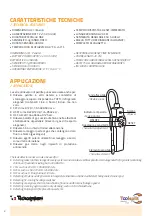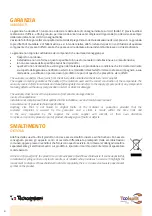
5
OPERAZIONE DI RIPRISTINO
/ RESETTING OPERATION
Premere il tasto RESET per 2 secondi per confermare l’operazione di ripristino.
Il cercafughe viene resettato ed in questa condizione il livello di refrigerante presente sulla punta viene ignorato,
questo permette all’utente la regolazione dello “zero” rispetto alla perdita (concentrazione più elevata).
In questo modo, il cercafughe otterrà la massima sensibilità. Il ripristino del cercafughe, fatta in ambiente senza alcun
refrigerante presente (aria fresca), fa in modo che qualsiasi livello di perdita sopra lo zero sia rilevato.
Press the RESET button for 2 seconds to confirm the resetting operation.
The leak detector is reset: in this condition, the level of refrigerant present on the tip is ignored, which allows the user to adjust
the “zero” with respect to the leak (higher concentration).
In this way, the leak detector will obtain the maximum sensitivity. When the leak detector is reset in an environment without
any refrigerant (fresh air), any leak whose level is above zero is detected.
PROCEDURA CONSIGLIATA
/ RECOMMENDED PROCEDURE
1. Alzare la sensibilità, solo quando una perdita non può essere rilevata; abbassare la sensibilità solo quando il ripri-
stino del unità non consente di azzerare la sensibilità stessa.
2. Nelle zone fortemente contaminate, resettare il rivelatore in modo che ignori le perdite presenti. Non spostare la
sonda durante il ripristino.
3. In zone ventose, anche una forte perdita può essere difficile da individuare. In questa condizione, è meglio scher-
mare la zona in cui si suppone ci sia la perdita.
4. Tenere presente che il cercafughe può segnalare una perdita anche se l’elemento sensibile entra in contatto con
solventi. Evitare di entrare in contatto con questi, mentre si effettua una ricerca della perdita.
Nel tempo l’elemento sensibile perderà la sua precisione. E‘ difficile prevedere esattamente quando sostituirlo, poi-
ché la sua longevità è direttamente correlata alle condizioni e frequenza di utilizzo. L’elemento sensibile dovrebbe
essere sostituito quando suona il cicalino o diventare instabile in un ambiente con aria pulita.
SOSTITUZIONE DELL’ELEMENTO SENSIBILE
/ REPLACING THE SENSITIVE ELEMENT
Over time, the sensitive element will lose its accuracy. It is difficult to predict exactly when to replace it, as its lifespan is
directly related to the conditions and frequency of use. The sensitive element should be replaced when the buzzer sounds, or
when it becomes unstable in a clean air environment.
1. Increase the sensitivity only when a leak cannot be detected; lower the sensitivity only when resetting the unit does not
allow resetting the sensitivity itself.
2. In heavily contaminated areas, reset the detector so that it ignores any leaks. Do not move the probe during resetting
operations.
3. In windy areas even an heavy leak may be difficult to spot. In this condition, it is best to shield the area where the leak is
supposed to be.
4. Keep in mind that the leak detector can signal the presence of a leak also when the sensitive element comes into contact
with solvents. Avoid coming into contact with these products while looking for a leak.
Содержание Toolsplit TSCE-500
Страница 7: ...7 NOTE NOTES...








